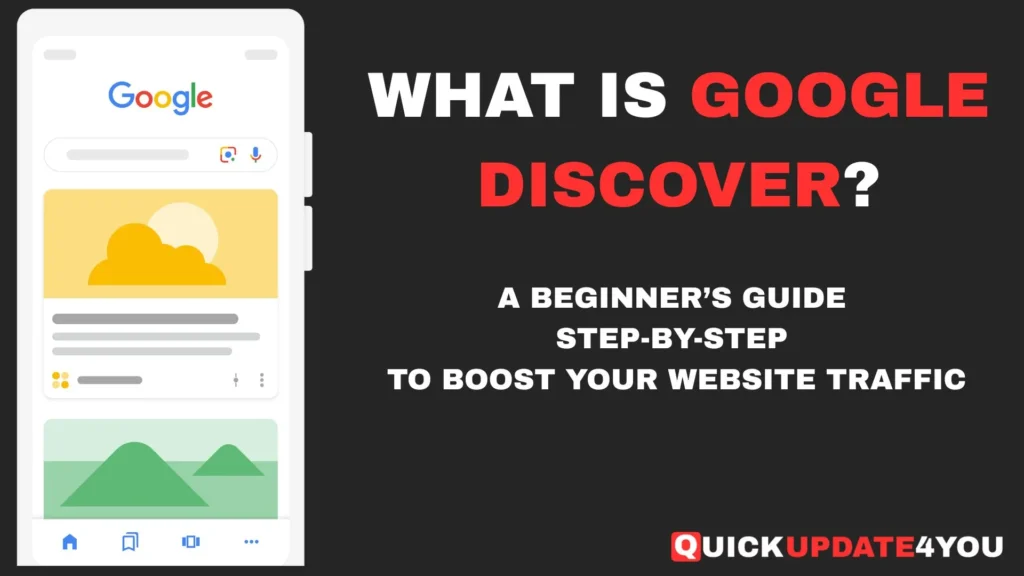Ever noticed articles appearing on your Chrome or Google app home screen without searching? That’s Google Discover — and getting featured there can send free, high-quality traffic to your blog. In this guide, i’ll learn step by step how to write a blog post that’s perfectly optimized for Discover.

Step 1: Choose a Trending Topic
Google Discover promotes timely, interest-based content — not just evergreen topics.
Use sources like:
- Google Trends to identify rising queries.
- News section in Search Console if available.
- Social buzz (X/Twitter, Reddit, Quora).
Create content around what people are already curious about instead of random keywords.
Step 2: Craft a Catchy, Honest Title
Your title is the first hook Discover users see. Follow these rules:
- Keep it between 50–65 characters.
- Make it descriptive, not clickbait.
- Use specific language: “How This App Doubled My Website Traffic in 1 Week” performs better than vague ones like “Amazing SEO Results.”
- Place keywords naturally at the beginning.
Bad Example: “Top Shocking Secrets About SEO!!!”
Good Example: “7 Proven SEO Strategies That Work in 2025”
Step 3: Write a Clear Meta Description
Your meta description appears below the title in Discover and Google results.
- Keep it between 120–150 characters.
- Summarize what the blog covers.
- Add action words like Learn, Discover, Find Out.
- Example:
Learn how to write SEO-rich blog posts that have a higher chance of appearing in Google Discover feeds.
Step 4: Structure the Blog with Headings (H2, H3)
Google loves organized content. Use:
- H1 for the main title.
- H2 for key steps (like this post).
- H3 for sub-points under each step.
Avoid single long paragraphs — 2 to 4 lines per section is ideal for mobile readers.
Step 5: Add High-Quality Images
Images can make or break Discover visibility. Follow these official rules :
- Use at least one main image at the top of your post.
- Use JPEG, PNG, or WebP formats for clarity.
- Minimum width: 1200 pixels.
- Add this meta tag in your page head:
<meta name="robots" content="max-image-preview:large" />- Use relevant, not generic, images (e.g., show product screenshots or real examples).
- Maintain aspect ratio: 16:9 or 4:3 for landscape.
Add descriptive ALT tags (e.g., “SEO dashboard showing website traffic increase”).
Step 6: Improve Readability & Engagement
Google Discover rewards time-on-page and engagement.
Write in a “conversational, teacher-style tone” (like this one).
- Use short sentences and bullet points.
- Add examples, quick tips, and small highlights.
- Add internal links to related posts and 1–2 reliable external links.
You can also include a “Bottom Line” summary at the end of each section for scanners.
Step 7: Add Schema Markup
Structured data helps Discover understand your post.
Example (use JSON-LD in your article <head>):
<script type="application/ld+json">
{
"@context": "https://schema.org",
"@type": "BlogPosting",
"headline": "How to Write a Blog Post That Gets Featured on Google Discover",
"image": ["https://yourwebsite.com/images/cover.jpg"],
"author": {
"@type": "Person",
"name": "Your Name"
},
"publisher": {
"@type": "Organization",
"name": "Your Blog Name",
"logo": {"@type": "ImageObject", "url": "https://yourwebsite.com/logo.png"}
},
"datePublished": "2025-10-21"
}
</script>
This tells Google exactly what your post is about.
Step 8: Optimize for Mobile & Speed
- Most Discover users are mobile.
- Use a responsive theme.
- Keep images compressed.
- Use lazy loading and caching plugins like WP Rocket or LiteSpeed Cache.
- Check speed using PageSpeed Insights or Core Web Vitals.
Step 9: Publish & Promote
After publishing:
- Submit your post URL in Google Search Console.
- Share on social media — Discover algorithms notice traffic surges.
- Encourage engagement (comments, shares, time spent).
Final Step: Build Trust (E-E-A-T)
- Show Google you’re credible.
- Add an author bio with a face.
- Link to credible sources.
- Write transparent, fact-verified, first-hand content.
If you found this information valuable, please leave a comment below—I’d love to hear your thoughts and answer any questions! Also, don’t forget to join my WhatsApp channel for more tips, updates, and exclusive content. Your support means a lot!

Thank you for providing valuable information.
Keep it up
Thanks
I highly recommend your website for authentic and specific, user friendly data
Thank you